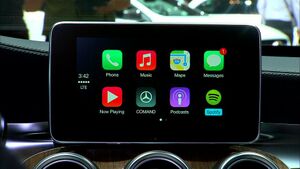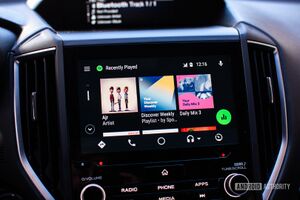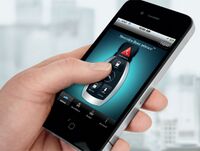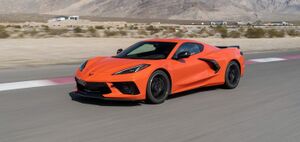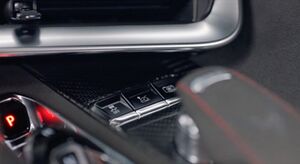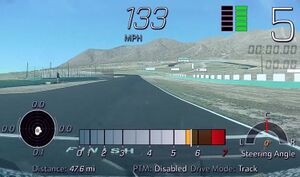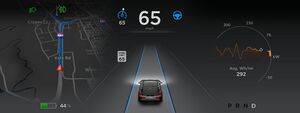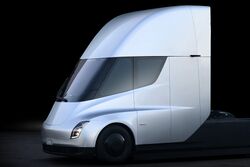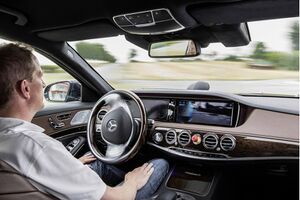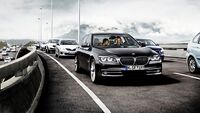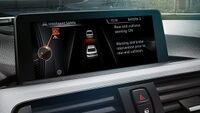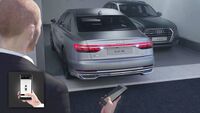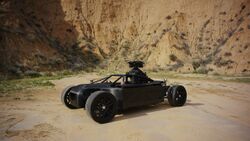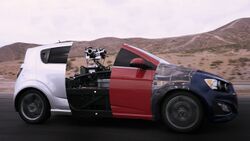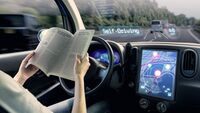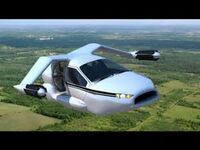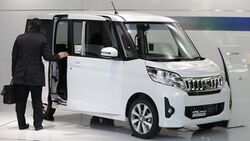New Media In the Automotive Industry
Technology and new media are being incorporated into various fields including the automotive industry. When the automobile was first invented, there was a lack of media-technology availability in automobiles. For decades, the only media offered in cars were CD players, cassette players, and the radio. Recently, however, many kinds of new media began to appear in the automotive world. Advanced technological options are now offered in cars such as Sync, MyFordTouch, iDrive, and etc. The change in the automotive world coincides with many societies' move from old media technologies, analog, into a digital era of wireless connectivity. New media technologies in cars allow consumers to control the climate inside the cabin as well as remotely starting vehicles with a tap of a button on their smartphones.
Apple Carplay
Apple Carplay was first released in 2014. Carplay is a safety system that allows users to control their iPhone while driving without compromising the drivers' focus on the road. The central console display of a car will function as an iPhone displaying basic applications such as Phone, Messages, Music, and Maps. The system utilizes Siri and voice commands enabling drivers to connect with one another easily while maintaining safety. Drivers can keep their hands on the steering wheel at all times without ever having the need to physically operate their iPhones.CarPlay features Siri voice control and is specially designed for driving scenarios. CarPlay also works with your car’s controls — knobs, buttons, touchpad, or touchscreen. And the apps themselves have been reimagined for the car, so you can use them while your eyes and hands stay where they belong.CarPlay is compatible with iPhone 6 to current models. [1]
Android Auto
Android Auto is a system similar to Apple Carplay, albeit on an Android Platform. It was developed by Google to compete with Apple's Carplay. It was also announced in 2014, and provides Android users with basic applications such as Phone, Maps, Music, and Voice Control on the car's display unit when connected.[2] In November 2016, Google released an update to allow users to run Android Auto on any device running Android 5.0 or newer. It allows it to be used on Android-powered head units, or simply on a personal Android device.[3] In January 2018, JVCKENWOOD released the world's first wireless Android Auto-capable head unit at CES 2018, making it capable of being operated without any wired connection.[4] Furthermore, in November 2018, Google pushed out a new version of Android Auto. The new update improves users' experience in media and messaging services. It provides new media browse and media search, allowing users to search for a song using Google assistance. Also, the function of the media preview keeps users to focus on the road and the integration of group messaging apps such as WhatsApp and Android Messages into Android Auto. [5]
Sync/MyFordTouch
Sync and MyFordTouch are multimedia platforms that Ford has created. They are systems that provide satellite radio and navigation. Ford plans to provide Wifi through the platforms in the future allowing easier communication between users and their cars, as well as users and their friends. [6]
Smartphone Integration
Everything revolves around smartphones these days so it is only logical to link smartphones to cars as well. Auto manufacturers have released multiple applications to allow users to perform certain functions on their car from their phones. One app is known as Mbrace from Mercedes. It allows users to find their car in a large lot, lock car doors, find a dealership, and much more. GM OnStar is another app that provides information about the car such as battery life, fuel economy, history, and will also send you a message if you forget to charge your car. Another application is Lexus RES+. This system allows users to remote start their car and set their temperature to their liking all from their phones.[7]
General Motors
Chevrolet Corvette
The Chevrolet Corvette has been the American sports car everyone knows of dating back all the way to 1953 where it was debuted at the Motorama show in New York City. The vehicle was a two-seat roadster made of fiberglass panels and Chevy's Blue Flame inline-six engine. This vehicle was something that would compete with the British two-seat roadsters of the time. Over the years the car's body style would change, the engines would be upgraded, and even astronauts would get a corvette when they came back from the moon. Finally, the newest iteration of the corvette the C8 as its known has taken the engine from the front of the car to the middle of the car for the first time ever in the history of the Corvette. Not only has it had its engine change places but it has had some new technology introduced in this model like the front nose lift system.[8]
Front Nose Lift
For the first time since the new Corvette C8 has come out this vehicle has received a front nose lift system. Since the front of this new car is so low to the ground they have given you the option to add a front nose lift system so that you don't damage the vehicle's front end when you are going over curbs and getting into your driveway at home. The especially interesting thing about this system is that the system can remember 1,000 locations you store in the vehicle which is then based on the GPS of the car so that the front nose can lift automatically before you would even think about pressing the button to activate the system. This system can raise the car in under 3 seconds and can add an additional 1.6 inches of ground clearance to the front of the car and this can all be done up to a speed of 24 mph.[9]
Performance Data Recorder
The Performance Data Recorder or PDR as it's known as was introduced in the Corvette C7 in 2015 and has now been added to multiple GM products and has even been brought back for the C8 Corvette. This system has been designed to capture HD video and audio which is then overlaid with performance-related statistics all done in realtime. This Performance Data Recorder is a great analytical tool that can help someone improve upon their driving skill but also you can share your great track day experience with other people. The information that is seen on the PDR can be customized to have the amount of accelerator pedal input, brake pedal input, the direction of G-force you are pulling, the speed you are going, the RPM of the engine, what gear you are in, and even the amount of steering input you are giving at any time while you are on the track.[10]
WiFi Hotspot
As of 2015, General Motors was the first to come out with the capability to have a Wi-Fi hotspot available in your vehicle. This technology was never seen before this in any other vehicle brand. GM first started with 30 vehicles that had this technology which ranged all the way from the smallest vehicle they made which was the Chevrolet Spark all the way up to the biggest vehicle they make the Suburban. This technological innovation in the car world would make it so everyone who was not driving could connect to the hotspot of the vehicle and everyone could watch their own movie to playing different games to someone who wanted to check their email. This technology has been adopted by many other car brands now but GM was the first to implement this technology in its vehicles.[11]
Tesla
Tesla, one of the biggest innovators in electric automotive technology is now producing very high tech vehicles. Their most famous model, the Tesla Model S, features twin fully electric motors. The entire car is controlled my a massive tablet in the center console of the car. The touch panel is 17 inches in diameter and has the most of the controls for the car.[12] There is radio, Bluetooth capability, temperature adjustments as well as pre-loaded apps. The car even has the ability to surf the web. The car also has a digital dashboard that has a smaller screen so that users can keep their eyes focused on the road. Tesla hopes to continue to develop the car as they now allow firmware updates. They are changing the way people interact with and use their cars.
Their first take on automobiles started from the Tesla Roadster model. Roadster took the styling from the Lotus Elise and improved it drastically to create a full-electric sports car. Roaster didn't perform very well in terms of sales and was discontinued after model year 2012. Since then Tesla has come up with the Model S, A full-sized sedan which has brought much light to the company. In 2015 they announced the Model X, a crossover they developed from the Model S platform. In 2017 they introduced Model 3, an affordable vehicle to lure in customers they were losing since Model S and Model X were substantially higher in price. Recently Tesla reintroduced their Roadster model along with a pickup truck which will come to the market in the upcoming years.[13]
Tesla has introduced the future of driving with its autopilot technologies. All new Tesla cars come standard with advanced hardware capable of providing Autopilot features today, and full self-driving capabilities in the future—through software updates designed to improve functionality over time. Autopilot advanced safety and convenience features are designed to assist you with the most burdensome parts of driving. Current Autopilot features require active driver supervision and do not make the vehicle autonomous. However, Elon Musk, CEO of Tesla, aims to have fully autonomous cars by 2020. [14]
AutoPilot
Tesla is growing to be known for their creative mindset and constant revolutionary ideas. Their latest creation was the ability to allow Tesla owners to drive their cars without them actually driving. What that essentially does is the car virtually controls itself with the motion sensor to sense the distance between cars and the speed in which they are moving at in order to forecast if switching lanes is a viable option. [15] This revolutionary idea was thought to one of the Tesla's greatest accomplishment, but up until recently, Tesla had encountered their first crash. Model S has a feature called "Summon" which allows you to maneuver the vehicle using only a smartphone from outside at slow speeds around tight spaces. Recently Tesla claimed that one of their customers had "summoned" their car and during this process, the individual had "accidentally" summoned his car, even though he had denied claims of that. When summoning his car, the car inched forward and hit the trailer in front of the car. [16] [17]
While autopilot is a growing invention for Tesla, it still needs to be tweaked out to prevent future accidents. But it is a huge step towards the future. Earlier this year Elon Musk, CEO of Tesla announced the Model S will be able to travel from Los Angeles to New York using Autopilot. [18] Although, as the year has gone by this accomplishment seems to keep getting pushed back. During 2017, there have been scattered AutoPilot 2.0 updates for the people who already own a Tesla with this technology. It was recorded that there were updates every three weeks during the start of 2017 but there hasn't been an update since May. These updates allowed the car to autopilot on a highway, up to 90 mph, and on local streets to 30 mph. A lot of they autopilot technology that was promised to the customers in 2016 has still yet to be updated into the new cars. Tesla has gotten too far ahead of itself and is now receiving backlash from customers and investors. People are second-guessing whether or not the company will be able to deliver what they said they would.[1]
Future
In November, Elon Musk unveiled the new semi-truck. He explained that this truck will be fully electric, able to hold almost 3 times more pounds than the other trucks and go up to 200 miles more on a highway at maximum weight. They claim that these trucks come equipped with semiautonomous capabilities that will help with changing and staying in lanes, which could contribute to the safety of the driver and other people on the road. The point of the truck is to create an alternative to hauling companies so that they can cut costs from the diesel truck. The price of the truck will be high but in the long run, companies will be able to save money across the years of having it. [2] By combining the fully electric truck and the new semiautonomous technology, companies will be able to cut down their costs and ensure an efficient system for hauling. The technology would also help prevent accidents since trailer truck accidents happen frequently, especially when the drivers are doing a long haul.
Cybertruck
The Tesla Cybertruck is unlike anything you’ve seen before: sharp creases and angles, like something doodled by a (talented) high schooler in that boring history class, or imagined for a science fiction movie. It is also a competitively priced pickup, listed at $40,000 to $70,000 with one to three motors. Speaking of science fiction, CEO Elon Musk said delivery will be in 2021, which is as little 58 weeks away, as much as 109 weeks away. Tesla has a history of missing ship dates, and not by a small margin.
The design is so far outside the pickup truck norm, with an angled bed cover, stainless steel body, and shatterproof windows (which of course shattered during the announcement), that there is considerable belief the design will change significantly between now and the, uh, 2021 launch date. So Cybertruck may be a working name. The Tesla Cybertruck is sized like a full-size pickup truck, which can be anywhere from 210 to 250 inches long depending on the cab size and truck bed size. For the Cybertruck, it’s 231.7 inches long with a 6.5-foot bed, 78.8 inches wide, and 75.0 inches high. So that answers the question of whether it’s a mid-size competitor (Chevrolet Colorado, Ford Ranger, Honda Ridgeline) or full-size competitor (Chevrolet Silverado, F-150, Ram 1500). It’s full-size. The Tesla has a roll-up bed cover and the tailgate drops down to act as a cargo ramp.
Most big pickups are body-on-(ladder) frame, which yields a heavier vehicle than unibody construction where there’s no separate frame. Truckers say it’s sturdier and lasts longer. Tesla is joining Honda in building a truck where the body panels — here, stainless steel — give the truck its rigidity and crash resistance. According to the introduction presentation by Musk, the cargo bed holds 3,500 pounds. The strongest model tows 14,000 pounds, which is a serious boat or travel trailer. (Also a serious drain on travel distance.)
The entry-level Cybertruck, $39,900, has a single motor, rear-drive, a range of 250-plus miles (these are all Tesla specs), a 0-60 time of 6.5 seconds, and a top speed of 110 mph. It tows 7,500 pounds. The dual-motor all-wheel-drive Cybertruck, $49,900, does 0-60 in 4.5 seconds, travels 300-plus miles on a single charge, and tows 10,000 pounds.
The top-end Cybertruck, $69,900, has three motors, runs 500-plus miles, does 0-60 in 2.9 seconds, tops out at 130 mph, and has the 14,000-pound tow capacity, more even than Ram 1500. (Which is shipping, and towing.) For this version, Musk says, production “is expected to begin in late 2022.”
Musk says the Cybertruck “is literally bulletproof to a 9mm handgun.” Designer Franz von Holzhausen couldn’t much dent the stainless steel body. He did better on the window glass.
Bulletproof Body, Armored Glass Musk says the stainless steel body is bulletproof, meaning it will stop a 9mm round (“full metal jacket, 115 grain [bullet]”). The intro site being in California, which looks unkindly on ricochets hitting someone in the audience (even if it’s just journalists), a sledgehammer was used and showed a dent but not penetration. Then it was on to proving the windows are armored nicely, too …
… and took out that window as well. For what it’s worth, a demo dropping the same ball down a tube onto the glass from a stepladder left that glass intact. And the car’s glass cracked but the plasticized layer held the glass pieces together, with no splinters that might hurt passengers in a crash or a gunfight.
Honda
Honda General
Honda in general is known for creating and developing some of the most reliable vehicles in the automotive industry. Many of their cars can last well over fifteen to twenty years and be driven upward of 400,000 miles. They may not be thought of the most classy, luxurious, or technologically advanced, but they are affordable and considered the working man's vehicle of choice. For many years one of the downsides to Honda's vehicles has always been their concept of a timing belt. This belt must usually be replaced every 100,000 miles or so and can cost a few thousand dollars each time. In recent years they have taken away the timing belt and installed metal chain belts instead like their competitors at Toyota, these last the life of the vehicle and are much more preferred.
Honda Sensing
Honda Sensing is a collection of safety features which are available on most Honda models for standard equipment. These features use cameras positioned around the vehicle and radar sensor system to help the give the drivers a complete view of the road and ability to handle unrespect situation. Honda Sensing will alert the driver when they are at risk of a collision, help the drive keep setup distance from other vehicles on highway, and correct steering and braking in dangerous driving conditions. Collision Mitigation Braking System (CMBS): reduces the chance of a frontal impact and will applied brake pressure if the vehicle does not start to slow down risk of collision is determined by computer system. Lane Keeping Assist System (LKAS): gently corrects steering position when the drive operating vehicle begins to leave the detected lane , keep the vehicle always are center of lane. Lane Watch Blind Spot Display: with Honda Lane Watch, any time you signal right, the camera on the passenger-side mirror will turn on and display live video on your Display Audio Touch-Screen, revealing nearly four times more than the average passenger-side mirror. Adaptive Cruise Control (ACC): uses a radar system which is hidden under front grille and a camera in the rearview mirror to helps the vehicle to maintain a set speed and keep a safe distance from the vehicle in front of you. Road Departure Mitigation System (RDM): adjusts steering and braking if you cross detected lanes without signaling. Traffic Sign Recognition (TSR):can notify drivers of posted speed limits with the use of a small camera.[20] 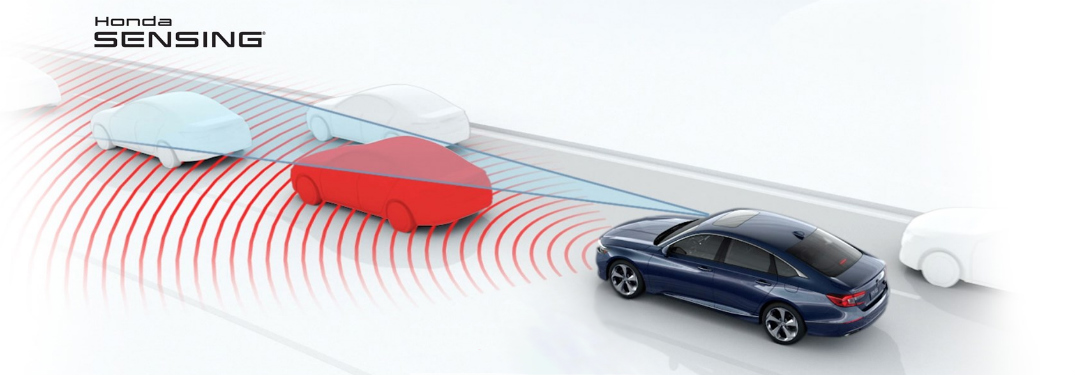
The Mercedes Star
In 1910 the three-pointed star was adopted by Paul and Adolf Daimler, sons of Gottlieb Daimler. During this time Stuttgart applied for the patent of the 4 pointed stars which became the emblem of DASA, Deutsche Aerospace AG in 1980 and now the emblem for European Aeronautic Defense Company(EADS). From 1910 on the three-pointed star was the logo used on all Mercedes vehicles, embedded into the radiator and later in the grills of every vehicle. Each of the three points on the Mercedes Star represented the different environmental areas the Mercedes Benz engine impacted, land, air, and sea. The original three-pointed star was used without the ring but as time progressed, the emblem
With a lineup that includes entry-level luxury cars to 12-cylinder SUVs that cost more than some houses, Mercedes-Benz is one of the world’s best-known luxury automakers.
Least Expensive: Separated by under $1,000 and riding on the same chassis architecture, the CLA-Class four-door and GLA-Class compact crossover are Mercedes-Benz’s least-expensive offerings.
Sportiest: Based on the AMG GT sports car, the AMG GT R sees the engineers at Mercedes-Benz’s AMG division upgrade the sportscar into a genuine supercar.
Popular: The Mercedes-Benz C-Class is the automaker’s most popular vehicle, beating out the E-Class line of cars and the new GLC-Class crossover.
Most Expensive: When Mercedes-Benz launched the new S-Class, it resurrected two names, Maybach and Pullman. For the Mercedes-Maybach Pullman, the company stretched an S-Class chassis to over 21 feet and gave it a starting price over $500,000 to make a luxury limousine worthy of its historic nameplate [21]
Ferrari
Enzo Ferrari founded Scuderia Ferrari in 1929 primarily to build racing cars. The entire business was focused on motorsports before it built its first road car in 1947. Enzo Ferrari was not interested in the idea of producing road cars when he formed Scuderia Ferrari.
Since then, Ferrari has built some of the world’s most dynamically capable, recognized and sought-after sports and supercars — and continues to do so today. The legendary "prancing horse" has also been a cornerstone of Formula One racing since the beginning of the World Championship series in the 1950s. Purchased by the Fiat Group in 1969, Ferrari has maintained a presence in motorsports, particularly Formula One. At the same time, the Italian automaker has also produced such famous road cars as the Dino, 288 GTO, F40, F50, and Enzo.
A town in northern Italy, near Bologna, Maranello has been home to Ferrari since the 1940s. At more than 250,000 sq meters, the factory's 45 buildings house more than 3,000 workers. It is here that passion, innovation, and technology combine to create the company’s GT and Formula 1 cars. Ferrari has built some amazing cars. Many agree that Ferrari has created some of the best ever. The company's loftiest efforts have been in the supercar market and it continues that tradition today with some of the current lineup already being touted as future classics. Ferrari’s philosophy "building the greatest cars in the world." So it is fitting when you think of awesome sports cars, one brand immediately comes to mind and that is Ferrari. Everything about Ferrari cars is great, unique and recognizable. Performance is amazing and they are constantly dragging the automotive industry into the future.
Maserati
Maserati, in full Maserati SpA, former name Officine Alfieri Maserati SA, Italian automobile manufacturer known for racing, sports, and GT (Grand Touring) cars. It is a subsidiary of Fiat Chrysler Automobiles NV and is based in Modena, Italy.
Officine Alfieri Maserati SA was founded in Bologna, Italy, in December 1914 by the brothers Alfieri, Ettore, and Ernesto Maserati. Spark plugs were the company’s first major product, and during World War I Maserati made the devices for aircraft engines. The Maserati emblem, modeled from the trident held by Neptune in a statue in Bologna’s Piazza Maggiore, was designed in 1920 by Mario Maserati, a fourth brother not otherwise connected to the company. Alfieri Maserati drove race cars for other manufacturers before settling down with his brothers to produce the first Maserati automobile, a race car named the Tipo 26 for the year of its debut. The most remarkable Maserati of the 1920s was the V4, a 16-cylinder race car that was clocked at 154 miles (248 km) per hour in 1929.
Alfieri died in 1932, and a younger Maserati brother, Bindo, joined the company that year. The Italian driver Tazio Nuvolari won races for Maserati in 1933 and 1934, driving the eight-cylinder 8CM model. In 1937 the surviving Maserati brothers sold the company to the Modena industrialist Adolfo Orsi but remained with the business for about 10 years afterward. Orsi’s cash infusion allowed the Maseratis to continue to produce successful racing cars. The American racer Wilbur Shaw drove a Maserati 8CTF, the “Boyle Special,” to victory in the Indianapolis 500 in 1939 and 1940. During World War II Maserati once again concentrated on the manufacture of spark plugs but also made batteries and electric delivery vehicles. After the war, Maserati expanded its product line to include sports cars and gran Turismo, or grand touring (GT), vehicles. A GT is a luxurious performance car, roomier than a sports car and better suited for long trips. The first Maserati GT was the A6 500, which went into production in 1948 with a six-cylinder engine and bodywork by Battista (“Pinin”) Farina of Turin. Maserati continued to build racing cars, however. The Argentinian driver Juan Manuel Fangio won the Formula One Grand Prix world championship in 1957 in a Maserati. Maserati’s premier sports car of the 1960s was the Tipo 60 “Birdcage” and its successors. The car got its nickname from the appearance of its welded tubular chassis. One of the company’s most successful models was the 3500 GT, a coupe that debuted in 1957. Maserati’s first Quattroporte (four-door) model appeared in 1963, and the original Maserati Ghibli, a coupe named after an African wind, was first offered in 1967. During the late 1960s, the French manufacturer Citroën purchased a controlling interest in Maserati and put a Maserati engine in one of its own cars, the Citroën SM. Under its own name, Maserati began producing the high-performance mid-engine Bora in 1971.
Maserati was purchased by the Argentinian industrialist Alejandro de Tomaso in the mid-1970s. The Biturbo, introduced in 1981 as a coupe with a twin-turbocharged engine, later became Maserati’s best-selling line of cars. The Chrysler Corporation purchased a stake in Maserati during the 1980s. The Chrysler TC (Touring Coupe) by Maserati, a joint venture aimed at the American market, was introduced in 1989 but was not considered successful, and the partnership with Chrysler was terminated.
Fiat, Italy’s leading carmaker, acquired Maserati from de Tomaso in 1993. In about 1997 Fiat turned management of Maserati over to Ferrari, a former rival that Fiat also controlled. After about 10 years’ absence, Maserati re-entered the American market in 2002 with the Spyder, a convertible based on the 3200 GT coupe that had been available in Europe since 1998. In 2005 Fiat took Maserati away from Ferrari and grouped it with Alfa Romeo, another Fiat property. Maserati then became the designated luxury brand of Fiat, which became Fiat Chrysler Automobiles in 2014. [22]
Technology
Unlike other luxury automobiles, Mercedes provides tons of technology features in their vehicle. From HUD(Heads Up Display) to Drive Pilot, which is Mercedes's take on Auto-Pilot from Tesla.[23] The goal of this technology is to provide self-driving features with no loss of luxury amenities that comes in Mercedes vehicles. Mercedes Drive Pilot system was introduced recently with 20% capabilities in the E-Class with full capabilities found on the S-Class. This system is able to drive the car with settings set by the driver and minimal driver interference similar to the Tesla Autopilot. This system takes a bit further by integrating mapping data and speed signs on the road for better driving dynamics. It is able to slow down steadily if the road ahead bends or comes to a sharp corner. It also recognizes updated speed signs that contradict with the mapping data and updates it. The car is able to handle speeds up to 120 MPH but will never exceed speeds limit without driver confirming the decision. One major feature of this system is being able to use mapping data to slow down to make a left or right turn after the driver uses the indicator. During this process, the driver is only responsible for controlling the steering. After the turn, the car then will continue to drive on its own. The car is also able to keep itself in lane and change lanes without any driver input aside from direction to change lane. These features are not to take the driver out of control but to help drivers with maneuverability.
BMW
BMW, a European car manufacturer widely known for their high-end luxury cars, has a new state of the art GPS system. Like most other vehicles nowadays, it has an LCD display in the center console in which you can control a wide selection of options within the car (radio, navigation, fuel consumption, iPod, cell phone, blue tooth, etc.) Unlike other companies, BMW's navigational system on its 10.3-inch touch screen display shows directions and map view, as well as maps in 3D and a photo-realistic depiction of places of interest, if desired.[24] BMW has introduced something new and revolutionary in the world of New Media and technology. BMW's all-new state of the art intelligent driving system consists of a few things never featured before in older model BMWs.
Heads-up display
What BMW refers to as "Heads-up display" is something we have never seen before. In addition to having the 10.3-inch touch screen display to show navigation, BMW has introduced a way in which the navigation is projected in the windshield right in front of the driver so the driver never has to take their eyes off of the road. On this display is the driver's current speed, the next navigation direction, the fuel consumption, and an alert whenever there are any upcoming obstacles such as a stop sign, traffic light, or yield sign up ahead. It is projected by a tiny projector that faces towards the windshield. Although some may feel that this projected display might become distracting, Car and Driver magazine has stated that the display is "comfortable to the eye" and "easy to read."[25]
Traffic Assist
Traffic Assist mode is currently only available on the European and US BMW models. Traffic assist allows you to sit back and relax while you are stuck in traffic. The system will slowly move you along when the cars in front of you are moving. It automatically maintains the desired distance from the vehicle in front, regulates your speed independently and brakes down to a standstill.[26] As long as one hand remains on the steering wheel, the car will do the rest of the work.[27]
Lane Change Warning
New to 2016 BMW models is the feature of lane change warning. [28] While a vehicle is approaching you from the back or side, the side view mirrors now have a little light-up indicator visible to the driver to warn you that there is a car passing. This reduces car accidents and minimizes more of the vehicle's "blind spots."
Driving Assistant
With the BMW Driving Assistant, you now have the option to be assisted at all times while driving. Some people are wary when it comes to driving and/or parking, but with the BMW Driving Assistant mode on the GPS display screen, you will be given steps on what to do. Using the camera-based systems and lane change warning, you get a 360 visual of what is going on around you displayed on the screen. If your car sees a pedestrian coming and you do not brake, the car will automatically slow the car to a halt for you. If the car feels you are inattentive or tired, the steering wheel will vibrate to inform you of this and recommend resting before continuing towards your destination.[29][30]
Audi
Virtual Cockpit
Lamborghini has recently incorporated electronic instrument clusters[[3]] into their cars. The Italian manufacturer has integrated Audi's, parent company of Lamborghini, 'Virtual Cockpit' into their entry-level model the Huracán. The Huracán features a large 12.3" TFT instrument panel that visualizes driving and infotainment information for the driver. [31] With high usability in mind, Lamborghini has clustered all display settings unto the digital dashboard streamlining the user interface with an intuitive and clean design. The panel depicts crucial information about the car such as Speed, temperatures, tire pressure, and the fuel gauge in digital form. At a click of a button, the digital dash can transform into a navigation screen, a rear-view camera display, or a driving dynamic mode selector. The Virtual Cockpit system utilizes Bluetooth, GPS, and internet technologies to provide convenience yet maintaining a driver-focused experience for the driver.[32] Since then this has been an add-on option on all Audi models. Certain Audi models still utilize the older MMI infotainment screen in the middle of the dashboard for the added viewing convenience and benefit of the passenger.[33] [34]
Virtual 360 View Camera
The Virtual 360 Camera is utilized on many Audi models and will be used in other vehicles in the Volkswagen group. Multiple cameras that cover the view outside the vehicle scan the outside surroundings for the driver and drivers are able to select from many different camera angles to aid in everyday driving and parking. These camera views are shown on the MMI display either in front of the drier in vehicles equipped with the Virtual Cockpit setup, or in the centrally mounted screen in most Audi models.
The Virtual 360 Camera presents the driver with a virtual onscreen representation of their vehicle as well as a stitched-together image from the multiple cameras mounted on the automobile of the car’s outside obstacles and other surroundings. This unique camera technology gives the driver better visibility when entering or leaving small parking spaces, intersections, tricky highway maneuvers, and attaching a trailer to the vehicle. The driver can easily swivel and zoom around the virtual depiction of the car and the vehicle’s surroundings.
Furthermore, there is also a view of the front and rear tires so that the driver can drive the vehicle up to a curb without risking scratching the wheels or tires from getting too close. On the front-facing camera, guiding lines on the screen can help the driver to line their wheels up when entering places like a car wash. Guiding lines in the reversing camera view that move in the direction of the steering wheel angle also makes it easier for a driver to park in perpendicular spaces as well. [35]
Remote Parking Pilot and Remote Garage Pilot
First introduced in the 2017 Audi A8, the Audi AI remote parking pilot and remote garage pilot utilizes laser scanner and camera technology allows for the automobile to independently steer itself into a parallel or perpendicular parking spot without a driver behind the wheel. The car modulates and determines the steering, accelerator, and brakes through its own technologically advanced self-driving system.
This piloting system is activated by the driver when he or she leaves the vehicle and pressing the Audi AI button in the driver’s myAudi mobile application. To monitor the car’s driving, the driver can watch a live camera feed from the car’s virtual 360-degree cameras on their mobile device. The automobile steers in an accurate manner and can decipher obstacles such as walls, concrete pillars, other vehicles, humans, and bicycles. The car can also determine if there are slight arches in the garage and can adjust accordingly.
Once the car has suitably parked itself, the piloting system automatically shifts the vehicle into park and shuts down the engine. This system is best utilized in parking garages or if the driver has already found a parking spot on the street because this technology is still undergoing approval in the U.S. to be used on outside roads.
When the driver is ready for their car to be retrieved, the driver again activates the AI pilot through the myAudi mobile app, and the vehicle will remember the route it took to steer itself into the parking spot and retrace its pathway out to meet the driver. [36]
The Mill Blackbird
Development
The Mill Blackbird is a concept vehicle intended to reduce costs for filming crews in producing car advertisement commercials. The vehicle was co-developed by The Mill, JemFX, Performance Filmworks and Keslow Camera. The vehicle and its photoreal CG capabilities are a cost effective solution to creating car advertisement videos by employing new media technologies. The Blackbird has skin points which allow CGI creators to generate images of virtually any car in the world. This removes one of the biggest overhead costs in filming car advertisements: the price of obtaining the actual car for the commercial.
Capabilities
The Blackbird can stand in the place of any car, and perform dangerous stunts without the worry of damaging the vehicle. The Blackbird not only copies the visual aspect of any car, but it also mimics the handling characteristics of any vehicle on the market as well. The Blackbird allows the film crew to adjust its chassis with regards to the width of its axle track and the length of its wheelbase. The Blackbird allows for further tweaks with its adjustable suspension that can be modified in terms of ride height, rigidity, and dampening. Furthermore, the electric motor is customizable. This revolutionary technology means that the blackbird can copy the looks and performance of any car on film without needing the actual car on set. As a consequence, car companies are able to cut down on the cost of producing an automotive advertisement.[38]
Virtual World
The Mill Blackbird features a 360-degree camera array and a tailor-made stabilization unit allowing the vehicle to capture vivid footage. A combination of high dynamic range imagery and 3D laser scanning generates a virtual version of the environment, producing 100% realistic CG renderings. [39] This technology opens up a whole new world for filmmakers. Filmmakers will be able to render out the surroundings of the Blackbird allowing for a plethora of virtual locations to choose from without ever needing to film inexpensive exotic locations. New Media technologies employed by the Blackbird amplify creativity while keeping costs down to a minimum for Filmmakers.[40]
Future of Automobiles
The future path that cars will take will be with the use of electric powertrains, with autonomous driving technology that requires minimal human driver input, and through sharing our vehicles with others.
All-electric cars such as the Tesla Model S and X, BMW i3, Jaguar I-PACE, and the Honda Clarity showcase the future of vehicle power as well as a beneficial solution to vehicle emissions. The largest effect of transportation, mainly cars, and trucks, is that it is one of the biggest contributors to global warming. Electric cars also do not emit any emissions like in a traditional gas or diesel-fueled vehicle. Instead, these vehicles rely on battery power as the main method of propulsion. Prices of electric cars has decreased in recent years with the release of cheaper vehicles such as the Tesla Model 3, Nissan Leaf, and Chevrolet Bolt. Combined with the electric car federal tax credit that is typically $2,500-$7,500, consumers who are in the market for a new vehicle can now comfortably purchase an electric car without any large drawbacks.
Ridesharing would help in reducing congestion on the highways and streets during peak rush hours. On average, most vehicles are only occupied by one occupant: the driver. The prevalence of ride-sharing services like Lyft and Uber have risen tremendously in recent years, and Lyft estimates that approximately 2.5 billion people will be moving into large cities within the next 15 years. Their idea is to discourage the sale of even more cars that will cause heavier traffic and to simply encourage people to share the transportation that is already on the road today.
Lastly, autonomous cars will also aid individuals to solve multiple consumer needs. Most accidents are caused by human error, and one company is aiming to lower the amount of car crashes that occur in one year. In August 2018, Lyft successfully completed the 5,000th self-driving ride for transporting occupants to their destinations. Lyft has a fleet of autonomous vehicles that operate similar to a limited use taxi in the Las Vegas area that mostly transport occupants to their hotels. These autonomous computer-driven vehicle drivers received on average a 4.96 out of a possible 5 stars for their short rides.
The use of batteries to power our vehicles as well as advanced computer technologies to create autonomous driving as well as coordinate and schedule ride-sharing services showcases how this growing reliance on human-computer interaction will revolutionize transportation in the coming generations.[41]
Flying Cars
Everything in technology is growing at a rapid pace, and automotive technology is no exception. We have come a long way from walking long distances to get from point A to point B to having horses to having rudimentary automobiles to now having technology advanced vehicles. Can cars go take it to the next step? For instance, flying cars were an idea 20 years ago because it represented a sense of what the future has to offer to us. At some as of yet unknown point in the future, cars will be able to fly. Cars today have an autopilot system installed in the cars so you don't have to actively engage with the vehicle and drive. The car automatically drives for you by maintaining the speed and steering of the vehicle. We put our trust and faith into these machines. Having a flying car means having to create a new system of traffic signals up in the air for cars alongside existing methods of air transport like helicopters and airplanes.[42]
Legal Issues
Several automakers have used vehicular technologies in addition to inaccurate calculation techniques to manipulate and inflate the fuel economy numbers of their automobiles.
Volkswagen Diesel Emissions Scandal
In 2015, Volkswagen diesel vehicles were using a "defeat device" to detect when the vehicle was undergoing a fuel-economy test. This allowed the car to alter its emissions output to influence a higher fuel economy rating. The Environmental Protection Agency (EPA) found many vehicle models with this device being sold in the United States. The Audi A3, Volkswagen Jetta, Volkswagen Beetle, and Volkswagen Passat were some of the numerous manufactured Volkswagen group vehicles that utilized this particular software. Volkswagen has since admitted that 11 million cars worldwide contained the "defeat device". This scandal has resulted in the recalling of millions of cars worldwide and the company had to set aside EUR 6.7 billion to cover all costs.[43] It is important to note that there are non-monetary costs that have been incurred due to the scandal, like damage to the brand and to the environment. Volkswagen has a large portfolio of subsidiaries that will implicitly be affected by the scandal. In September 2015, CEO Martin Winterkorn resigned from the company and Matthias Muller, the head of Porsche, was named the incoming CEO.
Mitsubishi eK Fuel Economy Overstatement Scandal
In April 2016, Mitsubishi admitted that the company has cheated on fuel-economy tests for one of the cars it produces in Japan. Engineers of the company had intentionally manipulated evaluations as well. The scandal affected about 620,000 cars sold in the Japanese market. The Mitsubishi eK used an improper testing technique to improve fuel efficiency. [44][45]
References
Technology
Unlike other luxury automobiles, Mercedes provides tons of technology features in their vehicle. From HUD(Heads Up Display) to Drive Pilot, which is Mercedes's take on Auto-Pilot from Tesla.[46] The goal of this technology is to provide self-driving features with no loss of luxury amenities that comes in Mercedes vehicles. Mercedes Drive Pilot system was introduced recently with 20% capabilities in the E-Class with full capabilities found on the S-Class. This system is able to drive the car with settings set by the driver and minimal driver interference similar to the Tesla Autopilot. This system takes a bit further by integrating mapping data and speed signs on the road for better driving dynamics. It is able to slow down steadily if the road ahead bends or come to a sharp corner. It also recognizes updated speed signs that contradict with the mapping data and updates it. The car is able to handle speeds up to 120 MPH but will never exceed speeds limit without driver confirming the decision. One major feature of this system is being able to use mapping data to slow down to make a left or right turn after the driver uses the indicator. During this process, the driver is only responsible for controlling the steering. After the turn, the car then will continue to drive on its own. The car is also able to keep itself in lane and change lanes without any driver input aside from direction to change lane. These features are not to take the driver out of control but to help drivers with maneuverability.
BMW
BMW, a European car manufacturer widely known for their high-end luxury cars, has a new state of the art GPS system. Like most other vehicles nowadays, it has an LCD display in the center console in which you can control a wide selection of options within the car (radio, navigation, fuel consumption, iPod, cell phone, blue tooth, etc.) Unlike other companies,BMW's navigational system on its 10.3-inch touch screen display shows directions and map view, as well as maps in 3D and a photo-realistic depiction of places of interest, if desired.[47] BMW has introduced something new and revolutionary in the world of New Media and technology. BMW's all-new state of the art intelligent driving system consists of a few things never featured before in older model BMWs.
Heads-up display
What BMW refers to as "Heads-up display" is something we have never seen before. In addition to having the 10.3-inch touch screen display to show navigation, BMW has introduced a way in which the navigation is projected in the windshield right in front of the driver so the driver never has to take their eyes off of the road. On this display is the driver's current speed, the next navigation direction, the fuel consumption, and an alert whenever there are any upcoming obstacles such as a stop sign, traffic light, or yield sign up ahead. It is projected by a tiny projector that faces towards the windshield. Although some may feel that this projected display might become distracting, Car and Driver magazine has stated that the display is "comfortable to the eye" and "easy to read."[48]
Traffic Assist
Traffic Assist mode is currently only available on the European and US BMW models. Traffic assist allows you to sit back and relax while you are stuck in traffic. The system will slowly move you along when the cars in front of you are moving. It automatically maintains the desired distance from the vehicle in front, regulates your speed independently and brakes down to a standstill.[49] As long as one hand remains on the steering wheel, the car will do the rest of the work.[50]
Lane Change Warning
New to 2016 BMW models is the feature of lane change warning. [51] While a vehicle is approaching you from the back or side, the side view mirrors now have a little light-up indicator visible to the driver to warn you that there is a car passing. This reduces car accidents and minimizes more of the vehicle's "blind spots."
Driving Assistant
With the BMW Driving Assistant, you now have the option to be assisted at all times while driving. Some people are wary when it comes to driving and/or parking, but with the BMW Driving Assistant mode on the GPS display screen, you will be given steps on what to do. Using the camera-based systems and lane change warning, you get a 360 visual of what is going on around you displayed on the screen. If your car sees a pedestrian coming and you do not brake, the car will automatically slow the car to a halt for you. If the car feels you are inattentive or tired, the steering wheel will vibrate to inform you of this and recommend resting before continuing towards your destination.[52][53]
Audi
Virtual Cockpit
Lamborghini has recently incorporated electronic instrument clusters[[4]] into their cars. The Italian manufacturer has integrated Audi's, parent company of Lamborghini, 'Virtual Cockpit' into their entry-level model the Huracán. The Huracán features a large 12.3" TFT instrument panel that visualizes driving and infotainment information for the driver. [54] With high usability in mind, Lamborghini has clustered all display settings unto the digital dashboard streamlining the user interface with an intuitive and clean design. The panel depicts crucial information about the car such as Speed, temperatures, tire pressure, and the fuel gauge in digital form. At a click of a button, the digital dash can transform into a navigation screen, a rear-view camera display, or a driving dynamic mode selector. The Virtual Cockpit system utilizes Bluetooth, GPS, and internet technologies to provide convenience yet maintaining a driver-focused experience for the driver.[55] Since then this has been an add-on option on all Audi models. Certain Audi models still utilize the older MMI infotainment screen in the middle of the dashboard for the added viewing convenience and benefit of the passenger.[56] [57]
Virtual 360 View Camera
The Virtual 360 Camera is utilized on many Audi models, and will be used in other vehicles in the Volkswagen group. Multiple cameras that cover the view outside the vehicle scan the outside surroundings for the driver, and drivers are able to select from many different camera angles to aid in everyday driving and parking. These camera views are shown on the MMI display either in front of the drier in vehicles equipped with the Virtual Cockpit setup, or in the centrally mounted screen in most Audi models.
The Virtual 360 Camera presents the driver with a virtual onscreen representation of their vehicle as well as a stitched-together image from the multiple cameras mounted on the automobile of the car’s outside obstacles and other surroundings. This unique camera technology gives the driver better visibility when entering or leaving small parking spaces, intersections, tricky highway maneuvers, and attaching a trailer to the vehicle. The driver can easily swivel and zoom around the virtual depiction of the car and the vehicle’s surroundings.
Furthermore, there is also a view of the front and rear tires so that the driver can drive the vehicle up to a curb without risking scratching the wheels or tires from getting too close. On the front-facing camera, guiding lines on the screen can help the driver to line their wheels up when entering places like a car wash. Guiding lines in the reversing camera view that move in the direction of the steering wheel angle also makes it easier for a driver to park in perpendicular spaces as well. [58]
Remote Parking Pilot and Remote Garage Pilot
First introduced in the 2017 Audi A8, the Audi AI remote parking pilot and remote garage pilot utilizes laser scanner and camera technology allows for the automobile to independently steer itself into a parallel or perpendicular parking spot without a driver behind the wheel. The car modulates and determines the steering, accelerator, and brakes through its own technologically advanced self-driving system.
This piloting system is activated by the driver when he or she leaves the vehicle and pressing the Audi AI button in the driver’s myAudi mobile application. To monitor the car’s driving, the driver can watch a live camera feed from the car’s virtual 360-degree cameras on their mobile device. The automobile steers in an accurate manner and can decipher obstacles such as walls, concrete pillars, other vehicles, humans, and bicycles. The car can also determines if there are slight arches in the garage, and can adjust accordingly.
Once the car has suitably parked itself, the piloting system automatically shifts the vehicle into park and shuts down the engine. This system is best utilized in parking garages or if the driver has already found a parking spot on the street because this technology is still undergoing approval in the U.S. to be used on outside roads.
When the driver is ready for their car to be retrieved, the driver again activates the AI pilot through the myAudi mobile app, and the vehicle will remember the route it took to steer itself into the parking spot and retrace its pathway out to meet the driver. [59]
The Mill Blackbird
Development
The Mill Blackbird is a concept vehicle intended to reduce costs for filming crews in producing car advertisement commercials. The vehicle was co-developed by The Mill, JemFX, Performance Filmworks and Keslow Camera. The vehicle and its photoreal CG capabilities are a cost effective solution to creating car advertisement videos by employing new media technologies. The Blackbird has skin points which allow CGI creators to generate images of virtually any car in the world. This removes one of the biggest overhead costs in filming car advertisements: the price of obtaining the actual car for the commerical.[60]
Capabilities
The Blackbird can stand in the place of any car, and perform dangerous stunts without the worry of damaging the vehicle. The Blackbird not only copies the visual aspect of any car, but it also mimics the handling characteristics of any vehicle on the market as well. The Blackbird allows the film crew to adjust its chassis with regards to the width of its axle track and the length of its wheelbase. The Blackbird allows for further tweaks with its adjustable suspension that can be modified in terms of ride height, rigidity, and dampening. Furthermore, the electric motor is customizable. This revolutionary technology means that the blackbird can copy the looks and performance of any car on film without needing the actual car on set. As a consequence, car companies are able to cut down on the cost of producing an automotive advertisement.[61]
Virtual World
The Mill Blackbird features a 360-degree camera array and a tailor-made stabilization unit allowing the vehicle to capture vivid footage. A combination of high dynamic range imagery and 3D laser scanning generates a virtual version of the environment, producing 100% realistic CG renderings. [62] This technology opens up a whole new world for filmmakers. Filmmakers will be able to render out the surroundings of the Blackbird allowing for a plethora of virtual locations to choose from without ever needing to film inexpensive exotic locations. New Media technologies employed by the Blackbird amplify creativity while keeping costs down to a minimum for Filmmakers.[63]
Future of Automobiles
The future path that cars will take will be with the use of electric powertrains, with autonomous driving technology that requires minimal human driver input, and through sharing our vehicles with others.
All electric cars such as the Tesla Model S and X, BMW i3, Jaguar I-PACE, and the Honda Clarity showcase the future of vehicle power as well as a beneficial solution to vehicle emissions. The largest effect of transportation, mainly cars and trucks, is that it is one of the biggest contributors to global warming. Electric cars also do not emit any emissions like in a traditional gas or diesel fueled vehicle. Instead, these vehicles rely on battery power as the main method of propulsion. Prices of electric cars has decreased in recent years with the release of cheaper vehicles such as the Tesla Model 3, Nissan Leaf, and Chevrolet Bolt. Combined with the electric car federal tax credit that is typically $2,500-$7,500, consumers who are in the market for a new vehicle can now comfortably purchase an electric car without any large drawbacks.
Ride sharing would help in reducing congestion on the highways and streets during peak rush hours. On average, most vehicles are only occupied by one occupant: the driver. The prevalence of ride sharing services like Lyft and Uber have risen tremendously in recent years, and Lyft estimates that approximately 2.5 billion people will be moving into large cities within the next 15 years. Their idea is to discourage the sale of even more cars that will cause heavier traffic and to simply encourage people to share the transportation that is already on the road today.
Lastly, autonomous cars will also aid individuals solve multiple consumer needs. Most accidents are caused by human error, and one company is aiming to lower the amount of car crashes that occur in one year. In August 2018, Lyft successfully completed the 5,000th self-driving ride for transporting occupants to their destinations. Lyft has a fleet of autonomous vehicles that operate similar to a limited use taxi in the Las Vegas area that mostly transport occupants to their hotels. These autonomous computer driven vehicle drivers received on average a 4.96 out of a possible 5 stars for their short rides.
The use of batteries to power our vehicles as well as advanced computer technologies to create autonomous driving as well as coordinate and schedule ride sharing services showcases how this growing reliance on human-computer interaction will revolutionize transportation in the coming generations.[64]
Flying Cars
Everything in technology is growing at a rapid pace, and automotive technology is no exception. We have come a long way from walking long distances to get from point A to point B to having horses to having rudimentary automobiles to now having technology advanced vehicles. Can cars go take it to the next step? For instance, flying cars were an idea 20 years ago because it represented a sense of what the future has to offer to us. At some as of yet unknown point in the future, cars will be able to fly. Cars today have an autopilot system installed in the cars so you don't have to actively engage with the vehicle and drive. The car automatically drives for you by maintaining the speed and steering of the vehicle. We put our trust and faith into these machines. Having a flying car means having to create a new system of traffic signals up in the air for cars alongside existing methods of air transport like helicopters and airplanes.[65]
Legal Issues
Several automakers have used vehicular technologies in addition to inaccurate calculation techniques to manipulate and inflate the fuel economy numbers of their automobiles.
Volkswagen Diesel Emissions Scandal
In 2015, Volkswagen diesel vehicles were using a "defeat device" to detect when the vehicle was undergoing a fuel-economy test. This allowed the car to alter its emissions output to influence a higher fuel economy rating. The Environmental Protection Agency (EPA) found many vehicle models with this device being sold in the United States. The Audi A3, Volkswagen Jetta, Volkswagen Beetle, and Volkswagen Passat were some of the numerous manufactured Volkswagen group vehicles that utilized this particular software. Volkswagen has since admitted that 11 million cars worldwide contained the "defeat device". This scandal has resulted in the recalling of millions of cars worldwide and the company had to set aside EUR 6.7 billion to cover all costs.[66] It is important to note that there are non-monetary costs that have been incurred due to the scandal, like damage to the brand and to the environment. Volkswagen has a large portfolio of subsidiaries that will implicitly be affected by the scandal. In September 2015, CEO Martin Winterkom resigned from the company and Matthias Muller, the head of Porsche, was named the incoming CEO.
Mitsubishi eK Fuel Economy Overstatement Scandal
In April 2016, Mitsubishi admitted that the company has cheated on fuel-economy tests for one of the cars it produces in Japan. Engineers of the company had intentionally manipulated evaluations as well. The scandal affected about 620,000 cars sold in the Japanese market. The Mitsubishi eK used an improper testing technique to improve fuel efficiency. [67][68]
References
- ↑ http://www.apple.com/ios/carplay/
- ↑ http://www.makeuseof.com/tag/what-is-android-auto-how-you-can-get-it/
- ↑ https://jalopnik.com/you-dont-have-to-buy-a-new-car-to-use-android-auto-now-1788654704
- ↑ https://www.androidpolice.com/2018/01/01/jvckenwood-will-pair-wireless-android-auto-capable-head-units-display-ces/
- ↑ https://www.androidauthority.com/android-auto-update-media-messaging-services-928057/
- ↑ http://www.popsci.com/cars/article/2010-02/remote-control-cars
- ↑ https://www.lexusresplus.com/index.jsp;jsessionid=dbZQWyyNby8yCTRH1GWnhqlLgDf6Chh2Ht22CtHWlLhncnD2BVpf!1083308190!2026027399?_requestid=8710
- ↑ https://www.caranddriver.com/features/g22035705/fully-vetted-the-visual-history-of-the-chevrolet-corvette/
- ↑ https://jalopnik.com/see-the-2020-c8-corvettes-nose-lift-in-action-1836907887,
- ↑ https://gmauthority.com/blog/2020/07/how-to-use-the-2020-corvette-performance-data-recorder-video/
- ↑ https://www.cbsnews.com/news/gm-is-making-your-car-a-rolling-wi-fi-hotspot/
- ↑ http://www.pcworld.com/article/2025314/tablet-envy-in-a-car-tesla-model-s-boasts-17-inch-touchscreen-control-panel.html
- ↑ https://www.google.com/search?biw=1280&bih=565&tbm=isch&sa=1&ei=pOgUWqvbI8eq0gLa2bLoBA&q=tesla+model+roadster&oq=tesla+model+roadster&gs_l=psy-ab.3..0l4j0i7i30k1j0i24k1.8091.8799.0.9034.6.6.0.0.0.0.173.437.0j3.3.0....0...1c.1.64.psy-ab..3.3.437...0i13k1.0.-AOyhg9jxNs#imgrc=XXNefONyqB1JYM:
- ↑ https://www.tesla.com/autopilot
- ↑ https://www.teslamotors.com/presskit/autopilot
- ↑ http://www.theverge.com/2016/5/11/11656496/tesla-model-s-autonomous-summon-mode-crash
- ↑ https://www.teslamotors.com/sites/default/files/images/presskit/software70/press01_autopilot.jpg?020
- ↑ http://bgr.com/2017/05/22/model-s-tesla-self-driving-new-york-los-angeles/
- ↑ https://www.extremetech.com/extreme/302489-tesla-unveils-cybertruck-f-150?source=extreme
- ↑ https://automobiles.honda.com/sensing
- ↑ https://www.motortrend.com/cars/mercedes-benz/
- ↑ https://www.britannica.com/topic/Maserati
- ↑ https://www.theverge.com/ces/2017/1/6/14177872/mercedes-benz-drive-pilot-self-driving-tesla-autopilot-ces-2017
- ↑ http://www.bimmerfest.com/forums/showthread.php?t=575838
- ↑ http://www.bimmerfest.com/forums/showthread.php?t=575838
- ↑ http://www.bmw.com/com/en/insights/technology/connecteddrive/2013/driver_assistance/intelligent_driving.html
- ↑ http://www.bmw.com/com/en/insights/technology/connecteddrive/2013/driver_assistance/intelligent_driving.html
- ↑ http://www.bmw.com/com/en/insights/technology/connecteddrive/2013/driver_assistance/intelligent_driving.html
- ↑ http://www.bmw.com/com/en/insights/technology/connecteddrive/2013/driver_assistance/intelligent_driving.html
- ↑ http://www.bmw.com/com/en/insights/technology/connecteddrive/2013/driver_assistance/intelligent_driving.html
- ↑ http://www.lamborghini.com/en/models/huracan-lp-610-4/explore/#cfg14,A3A3,RAD,C3E,BAV,PC1,MAD,PD1,0UJ,0UJ_NA,0UJ_FCU_VF,LRA,2PF,EMI,NR1
- ↑ http://images.cdn.autocar.co.uk/sites/autocar.co.uk/files/styles/gallery_slide/public/luc_7448.jpg?itok=bgol4rRz
- ↑ http://o.aolcdn.com/hss/storage/midas/63f39e79f1a0527a3f1cc39364aef5b1/200090315/lead14-2015-lamborghini-huracan-fd.jpg
- ↑ http://www.blogcdn.com/slideshows/images/slides/246/769/8/S2467698/slug/l/03-lamborghini-huracan-geneva-1-1.jpg
- ↑ https://www.audi-mediacenter.com/en/technology-lexicon-7180/driver-assistance-systems-7184
- ↑ https://www.audi-technology-portal.de/en/electrics-electronics/driver-assistant-systems/audi-a8-audi-ai-parking-pilot-and-garage-pilot
- ↑ http://cdn.themill.com/media/00000014993.jpg
- ↑ http://cdn.themill.com/media/00000014995.jpg
- ↑ http://www.themill.com/portfolio/3002/the-blackbird%C2%AE
- ↑ https://www.youtube.com/watch?v=OnBC5bwV5y0
- ↑ https://singularityhub.com/2018/08/23/the-future-of-cars-is-electric-autonomous-and-shared-heres-how-well-get-there/
- ↑ http://www.theatlantic.com/magazine/archive/2016/05/when-cars-fly/476382/
- ↑ http://www.nytimes.com/interactive/2015/business/international/vw-diesel-emissions-scandal-explained.html?_r=0
- ↑ http://www.japantoday.com/category/business/view/mitsubishi-motors-has-cash-to-weather-mileage-scandal-but-brand-battered-again
- ↑ http://media.npr.org/assets/img/2016/04/20/gettyimages-470047413_wide-57455fcebcf1c89cd7de4cd8b4f12e5f53de86e4-s800-c85.jpg
- ↑ https://www.theverge.com/ces/2017/1/6/14177872/mercedes-benz-drive-pilot-self-driving-tesla-autopilot-ces-2017
- ↑ http://www.bimmerfest.com/forums/showthread.php?t=575838
- ↑ http://www.bimmerfest.com/forums/showthread.php?t=575838
- ↑ http://www.bmw.com/com/en/insights/technology/connecteddrive/2013/driver_assistance/intelligent_driving.html
- ↑ http://www.bmw.com/com/en/insights/technology/connecteddrive/2013/driver_assistance/intelligent_driving.html
- ↑ http://www.bmw.com/com/en/insights/technology/connecteddrive/2013/driver_assistance/intelligent_driving.html
- ↑ http://www.bmw.com/com/en/insights/technology/connecteddrive/2013/driver_assistance/intelligent_driving.html
- ↑ http://www.bmw.com/com/en/insights/technology/connecteddrive/2013/driver_assistance/intelligent_driving.html
- ↑ http://www.lamborghini.com/en/models/huracan-lp-610-4/explore/#cfg14,A3A3,RAD,C3E,BAV,PC1,MAD,PD1,0UJ,0UJ_NA,0UJ_FCU_VF,LRA,2PF,EMI,NR1
- ↑ http://images.cdn.autocar.co.uk/sites/autocar.co.uk/files/styles/gallery_slide/public/luc_7448.jpg?itok=bgol4rRz
- ↑ http://o.aolcdn.com/hss/storage/midas/63f39e79f1a0527a3f1cc39364aef5b1/200090315/lead14-2015-lamborghini-huracan-fd.jpg
- ↑ http://www.blogcdn.com/slideshows/images/slides/246/769/8/S2467698/slug/l/03-lamborghini-huracan-geneva-1-1.jpg
- ↑ https://www.audi-mediacenter.com/en/technology-lexicon-7180/driver-assistance-systems-7184
- ↑ https://www.audi-technology-portal.de/en/electrics-electronics/driver-assistant-systems/audi-a8-audi-ai-parking-pilot-and-garage-pilot
- ↑ http://cdn.themill.com/media/00000014993.jpg
- ↑ http://cdn.themill.com/media/00000014995.jpg
- ↑ http://www.themill.com/portfolio/3002/the-blackbird%C2%AE
- ↑ https://www.youtube.com/watch?v=OnBC5bwV5y0
- ↑ https://singularityhub.com/2018/08/23/the-future-of-cars-is-electric-autonomous-and-shared-heres-how-well-get-there/
- ↑ http://www.theatlantic.com/magazine/archive/2016/05/when-cars-fly/476382/
- ↑ http://www.nytimes.com/interactive/2015/business/international/vw-diesel-emissions-scandal-explained.html?_r=0
- ↑ http://www.japantoday.com/category/business/view/mitsubishi-motors-has-cash-to-weather-mileage-scandal-but-brand-battered-again
- ↑ http://media.npr.org/assets/img/2016/04/20/gettyimages-470047413_wide-57455fcebcf1c89cd7de4cd8b4f12e5f53de86e4-s800-c85.jpg
